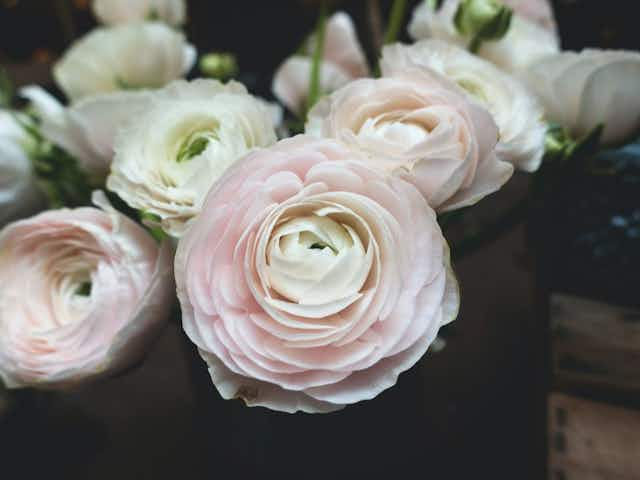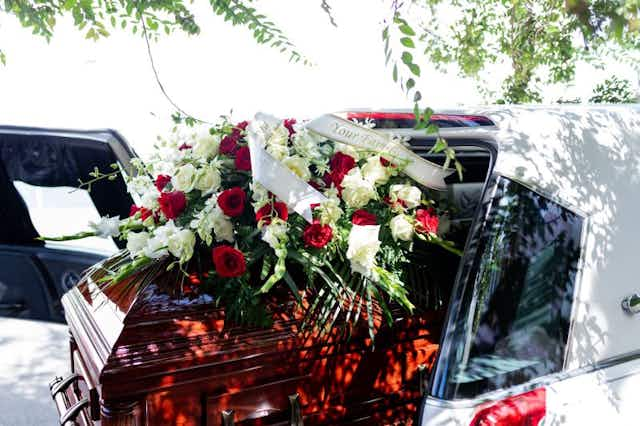18 Funeral Traditions From the U.S. Explained
Updated
Published


Cake values integrity and transparency. We follow a strict editorial process to provide you with the best content possible. We also may earn commission from purchases made through affiliate links. As an Amazon Associate, we earn from qualifying purchases. Learn more in our affiliate disclosure.
Sociologists, anthropologists, and archeologists learn a lot about current and past civilizations based on their end-of-life customs and traditions. What would they discover about us based on current American funeral traditions?
Many funeral traditions are based on the religious beliefs of the person who died. They are also based on the geographic area where the person lived and the societal group to which they belonged.
Here are some general funeral traditions prevalent in the U.S. and the reasons behind them. Understanding some of these traditions may help you plan your own eventual end-of-life services or may assist you in planning the funeral for someone else.
1. Services are usually not held in homes
Earlier in our country’s history, the body of the deceased would first be displayed at home before the services were held. In recent decades, this does not typically happen.
In fact, family and friends may now only gather at an individual house for sitting Shiva or for a reception or repast.
2. Funeral professionals prepare the body
In some cultures, family members prepare the body for burial or cremation.
This is not typical of American families, as we usually rely on professionals to perform these duties. Of course, there are exceptions to this general rule.
3. More Americans are choosing to be cremated
Throughout the years, more Americans chose to be buried rather than cremated.
This has changed over the last decades as now cremation is slightly more popular than burial. This trend may not be prevalent in all societal groups and religions.
4. Bodies are sometimes displayed at visitations for funerals
Many times, the deceased body is displayed at a visitation or funeral. A funeral home employee typically prepares and dresses the body for display. Attempts are made to make the deceased look as life-like as possible, and the body is often dressed in clothing previously worn by the individual.
This practice allows people to see the person’s body one last time before it is buried, entombed, or cremated.
5. Flowers are often used to decorate a casket or on display at a funeral service
Floral displays are typically one of the only decorations present at a funeral service. Even though the Victorians assigned flowers and plants symbolic meanings, flowers for modern funerals are often chosen based on personal preference.
The family members often purchase floral displays or casket sprays. Extended family members and friends often buy additional displays and plants to give to the members of the immediate family. If families prefer, they can request in the obituary that individuals make contributions to non-profit organizations instead of purchasing plants, flowers, or other sympathy gifts.
6. A person’s faith and beliefs are an essential part of the funeral service
Even if the funeral service is held in a funeral home instead of a house of worship, some aspect of his or her belief system is typically evident in the choice of music or the text of the service. Whether the individual was Christian, Jewish, Hindu, Muslim, or atheist, it can be inferred by the symbols on display at the funeral or by what is said during the service.
The individual’s beliefs of what happens after death are also usually apparent, as those beliefs are often linked with their religion.
7. Some of the items purchased for the end-of-life services may be personalized
You can purchase caskets that display a cross or Star of David. You can also buy urns with a motorcycle model on top or a Batman symbol across the front.
Many end-of-life items can now be personalized to show an individual’s beliefs and preferences. Sometimes these items may need to be purchased from online retailers. The personalization options are almost endless.
8. Readings at funerals often come from scripture or religious texts
People often turn to the Bible, Torah, or other religious texts to find readings for a funeral. Of course, these readings reflect the belief of the deceased individual.
There are particular selections that are often read during a funeral. Sometimes families turn to the officiant or religious leader for help in making a selection. Other times the choice may be based on words and ideas that were important to the deceased.
Poems are also often used at both religious and secular funerals. Although there are many popular funeral poems, they can also be chosen based on what the deceased enjoyed reading during their life.
9. Mourners often wear black or muted colors
Typically, people often wear black or muted colors to a funeral. These colors typically symbolize a mournful attitude.
Of course, there are exceptions to this rule, and they are generally based on a person’s religion or personal preference.
10. People often dress formally for funerals
Even though American society is dressing less formally now than what was typical in the past, most people still wear suits and dresses to funerals. Sometimes, families may post a special request in their loved one’s obituary that requests that funeral attendees wear jeans, specific colors, or a less-formal clothing style.
The style of dress is often dependent on the societal group and geographic location of the individual who died. People may also be more likely to dress formally for funerals held at churches than ones held outside.
11. Eulogies are often read at a funeral service
Typically, either an officiant or family member reads an individualized eulogy at a funeral. This eulogy typically reflects the deceased’s religious beliefs. The eulogy also gives a positive message about the deceased and may list accomplishments and attributes.
A person’s negative traits are usually not talked about during a eulogy. If they are brought up, they are typically light-hearted and talked about in an amusing light.
12. Music is usually an important part of an American end-of-life service
Usually, instrumental or vocal music is a part of a funeral service. If the funeral is held at a church or another house of worship, the music may often be religious. You may hear more secular pieces during a visitation or if the service is held at a funeral home.
There are certain funeral songs that you may often hear repeatedly at American end-of-life services. Since more personalized services have become common, you may hear a wider variety of music at funerals than what you may be used to hearing.
13. Photos are typically displayed at visitations and funerals
Photographs of individuals during the happy moments of their lives are often displayed at American funerals. A photo may be enlarged and displayed, especially if there is not an open-casket funeral.
Sometimes a presentation of photos is displayed on a screen, or other times the pictures may be presented as a collage or in albums.
14. A service usually accompanies the body being placed in its final resting place
Whether the body is buried, entombed, or cremated, an additional service often accompanies this action. Sometimes this is the only service that may be held for the individual. Other times, this may be the final ceremony in a series of services.
Graveside services or scattering ceremonies are typically shorter than funeral services since they are usually outside.
15. Military members may be honored during his or her funeral
Often members of the military are given special honors at their funerals.
These military honors may be given whether the deceased was an active member or served in the past. Rituals like this can include the 21 gun salute for a military funeral.
16. Some families choose to have private funeral services for their loved ones
There could be a variety of reasons that a family would choose to have a private funeral service for their loved ones. It could be related to the circumstances that lead up to the individual’s death or based on personal preferences or economic reasons.
Sometimes no funeral service is given for the deceased.
17. Meals or refreshments are often served following a funeral service
Sometimes light refreshments or meals are served following an end-of-life service at a funeral reception. This could be in a community room, church hall, restaurant, or an individual’s home.
This gathering allows family members and other mourners to share memories of the deceased.
18. Friends and extended family members often give meals to the mourning family
It is common for people to drop off casseroles, desserts, or breakfast items to families who are mourning the loss of a loved one.
Those who have to travel for their loved one’s funeral may all receive gift cards for restaurants.
Funeral Traditions Vary Among Communities and Religious Groups
It’s challenging to write about American funeral traditions because they can vary so much among communities. Regardless of the individual’s beliefs or societal group, funerals have one thing in common. They are meant to give people an opportunity to honor and say goodbye to someone they loved. This need crosses all ethnicities, religions, political affiliations, and other ways we choose to label ourselves.
If you feel strongly about what you want your funeral to look like, make sure you share your preferences with others. Start your funeral planning by utilizing Cake’s resources today.



